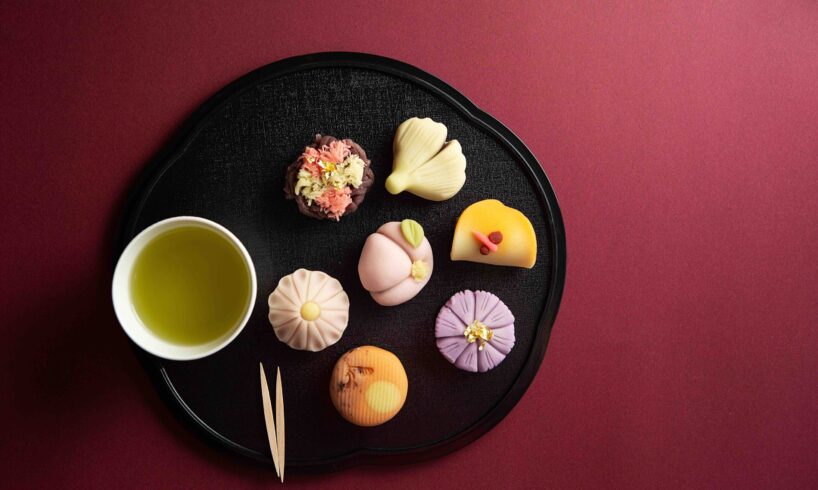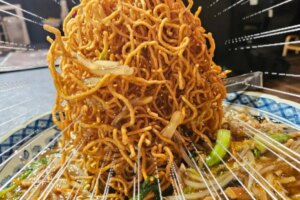
Within Japanese cuisine, savory dishes like sushi and ramen have a tight grasp of the worldwide spotlight. But an often overlooked realm is wagashi, traditional Japanese sweets that delight both the eyes and tastebuds.
These confections date back thousands of years — evolving through Chinese cuisine, sado (tea ceremony tradition) and the influence of Western patisserie techniques. Wagashi are thoughtfully crafted, just sweet enough to perfectly complement a cup of tea. Their artistic charm also adds a layer of curated aestheticism and omotenashi (hospitality) that always impresses.
“Wagashi” simply means “Japanese sweet.” While the word is most commonly associated with the beautiful namagashi (“raw” Japanese sweets) that are served at tea ceremonies, wagashi is an all-encompassing category. Their diverse designs, consistencies and preparation methods also take inspiration from the seasons and regions in Japan. Here is an introduction to some of the most popular traditional sweets that you should try.
Mochi
Perhaps the Japanese sweet with the most contemporary global recognition, mochi is made from glutinous rice that’s typically pounded with a heavy wooden mallet into a sticky dough. There is even a legend that says rabbits are busy making mochi on the moon.
Mochi has played a significant role in Japanese culture. Said to be brought from China in the Yayoi period (c. 300 BC–250 AD), and popularized through religious ceremonies and the aristocracy of the Heian era (794–1185), mochi has been prepared and enjoyed during weddings, New Year’s celebrations and other special occasions for generations. Today, it has a staple presence not just at parties, but at everyday gatherings and kitchen tables as well.
Mochi can be thought of as its own category, appearing in an assortment of formats both savory and sweet. As a dessert, variations include daifuku (mochi stuffed with fillings such as anko or fruit), sakuramochi (pink rice cakes wrapped in a salted cherry blossom leaf) and kusamochi (mochi kneaded with mugwort leaves). Ice cream and custard-filled mochi are modern twists for those less fond of anko (sweet bean paste).
Warabimochi
Despite its name, warabimochi is technically not a type of mochi. Instead of rice flour, traditional warabimochi is made of bracken starch extracted from the roots of the wild warabi plant. As bracken starch is a laborious and rare ingredient to get a hold of, warabimochi may also be made from sweet potato or tapioca flour.
Flour, sugar and water are mixed, then cooked, chilled and coated in kinako (toasted soybean flour) and kuromitsu (black sugar syrup). The result is a delicate jelly-like treat that’s chewy and addicting.
Taiyaki
Catching the attention of passersby with its cute fish-shaped mold and irresistible aroma, taiyaki is a pancake-like snack filled with anko. You can also find chocolate or custard varieties, and chilled versions that are a refreshing treat during summer days.
Its name directly translates to “baked sea bream” but rest assured that there is no seafood inside. The treat is modeled after the tai (sea bream) as a symbol of good fortune and prosperity.
Konpeito
You may recognize these colorful candies as seen in Studio Ghibli’s Spirited Away, treasured by the soot sprites of Yubaba’s bathhouse.
Konpeito are small star-shaped sugar candies that were first introduced to Japan by Portuguese traders and missionaries in the mid-16th century. The name derives from the Portuguese word for confection, “confeito.” After captivating warlord Oda Nobunaga, konpeito became popular amongst the samurai and noble families during the Sengoku era (1467-1600). At a time when sugar was rare, konpeito was considered a luxury few could afford. Nowadays, konpeito is easily found and comes in many colors and flavors. They are even an official item included in the Ministry of Defense’s Emergency Food rations and in the Japanese military’s food kits. Their pretty crystal shape also makes them wonderful as gifts and souvenirs.
Dorayaki
Another wagashi with a pop culture reference, dorayaki is the beloved sweet treat of Doraemon and where he gets his name from. Inspired by the shape of dora (musical gongs), dorayaki are cake patties that sandwich sweet bean paste.
Like konpeito, dorayaki are also a product of Portuguese cross-cultural exchange during the 16th century. The Portuguese “castella,” a light and fluffy sponge cake that was shared by missionaries in Nagasaki. A slice of castella cake can be enjoyed by itself, but when baked as discs and combined with anko, it becomes the even more scrumptious dorayaki.
Dango
Dango is closely connected to mochi. Taking the pounded mochiko (rice flour), the dough is then rolled into small bite-sized pieces, steamed and served on bamboo skewers. Varieties include mitarashi dango which are dipped in a sweet soy sauce glaze. Anko dango have a sweet bean paste topping and kuri dango have chestnut puree, an autumn favorite. Hanami dango have a stack of green, white and pink dumplings symbolizing springtime blossoms. As their name suggests, these dango are popular for hanami (flower viewing) and they are even represented in the emoji keyboard.
Dango has become so ubiquitous in Japanese culture that it has also become the go-to name for other spherical objects. Bun hairstyles are called odango, and Sailor Moon’s boyfriend Mamoru Chiba gives her the nickname “odango” due to her iconic bun-topped twin tails.
Anmitsu
Anmitsu is a dessert bowl made of various components, typically consisting of anko, kuromitsu, fruits, cubed kanten (agar jellies) and shiratama (dango balls) for a symphony of flavors.
Developed in the Meiji era (1868-1912), anmitsu was originally just kanten drizzled with syrup. The bowls grew more elaborate with additional toppings that mix different flavors and textures — together they create a beautiful arrangement. Modern versions may also add ice cream, wafers, matcha and maraschino cherries.
Monaka
With their crispy shells and soft filling, monaka are elegant anko-stuffed rice wafers. The confections go back to the Edo era (1603-1867), when they began as simple discs made of steamed rice powder and water, which were then sprinkled with sugar. It was during the Meiji restoration that the monaka got its new look akin to how we see them today with intricate wafer designs ranging from patterns to chrysanthemums.
Related Posts
Discover Tokyo, Every Week
Get the city’s best stories, under-the-radar spots and exclusive invites delivered straight to your inbox.





